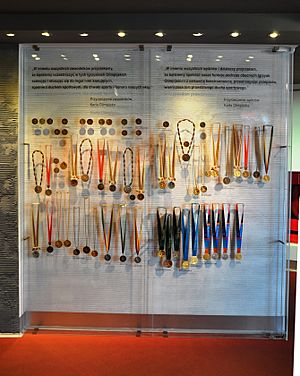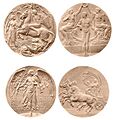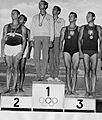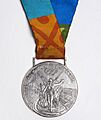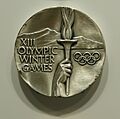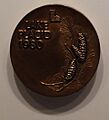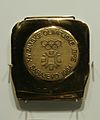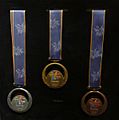Olympic medal facts for kids
Quick facts for kids Olympic medals |
|
|---|---|

A silver medal awarded to the winner of an event at the first modern Olympic Games in 1896.
|
|
| Given for | Given to successful competitors in various Olympic Sports |
| Presented by | International Olympic Committee |
| History | |
| First award | 1896 |
| Website | www.olympic.org/ |
Olympic medals are special awards given to athletes who do really well at the Olympic Games. There are three types of medals: gold, silver, and bronze. Gold goes to the first-place winner, silver to second place, and bronze to third place. The rules for giving out these awards are very detailed.
The look of Olympic medals has changed a lot since the first Games in 1896. For example, the size of medals for the Summer Olympic Games has varied. A design used from the 1928 Games was replaced at the 2004 Games in Athens. The old design showed the Roman Colosseum, but the new one features the Greek Panathenaic Stadium. This stadium is a better symbol for the Olympic Games because they started in Greece. Medals for the Winter Olympic Games have always had different designs. They often show snowflakes and the sport the medal is for.
Some countries also give money or gifts to athletes who win medals. This depends on the type and number of medals won. For example, at the 2024 Paris Games, 33 countries said they would give prizes to medal winners. Fifteen of these countries offered cash prizes of over $100,000.
Contents
History of Olympic Medals
Ancient Olympic Games Awards
In the Ancient Olympic Games, winners did not receive medals. Instead, they were given an olive wreath. This wreath was made from a branch of a wild-olive tree that grew in Olympia. It was shaped into a circle or a horseshoe. People believed that Heracles first introduced this wreath as a prize. He did this to honor Zeus after winning a running race.
Modern Olympic Medals Begin
When the modern Olympic Games started in 1896, athletes began receiving medals. However, gold medals were not given out at the very first Games in Athens, Greece, in 1896. Winners received a silver medal and an olive branch. Second-place athletes got a laurel branch and a copper or bronze medal.
The 1900 Summer Olympics were unique because they were the only Games to have rectangular medals. These were designed by Frédérique Vernon. Gold-plated silver medals were given for first place in some sports. Silver medals were for second place, and bronze medals for third. But in many sports, medals were not given out at all. Instead, athletes received cups or other trophies.
The tradition of giving gold, silver, and bronze medals for the top three places began at the 1904 Summer Olympics in St. Louis, Missouri, USA. The International Olympic Committee (IOC) later decided to give gold, silver, and bronze medals to the top three athletes from the 1896 and 1900 Games as well. If there is a tie for a top-three spot, all tied athletes receive the correct medal. Some combat sports, like boxing and judo, give out two bronze medals per event. This means more bronze medals are awarded overall.
Besides medals, athletes who finish from first to eighth place receive an Olympic diploma. Also, the names of all medal winners are written on a wall at the main host stadium. All athletes also get a special participation medal and diploma.
How Olympic Medals Are Made
The International Olympic Committee (IOC) sets the rules for how medals should look and what they should be made of. They work with the country hosting the Games to decide the final design. Here are some of the rules:
- Who Gets Them: The top three athletes in each event.
- Shape: Usually round, with a loop for a chain or ribbon.
- Size: At least 60 millimeters wide.
- Thickness: At least 3 millimeters thick.
- Materials:
- Gold Medal: It must be at least 92.5% silver. It is then covered with 6 grams of pure gold. In 2021, a gold medal from the Tokyo Games was worth about $800 just for its metal.
- Silver Medal: It is 92.5% silver. In 2021, a silver medal from the Tokyo Games was worth about $460.
- Bronze Medal: In 2010, it was 97% copper with small amounts of tin and zinc. In 2021, a bronze medal from the Tokyo Games was worth about $5.
- Details: The medal must have the name of the sport it was awarded for.
The first Olympic medals in 1896 were designed by a French artist named Jules-Clément Chaplain. They showed Zeus holding Nike, the Greek goddess of victory, on one side. The other side showed the Acropolis in Athens. The city hosting the Games usually makes the medals. Until 1912, gold medals were made of solid gold!
The Trionfo Design
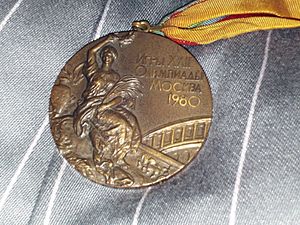
In 1923, the IOC held a competition for artists to design the medals for the Summer Olympic Games. A design called Trionfo by Giuseppe Cassioli was chosen in 1928. The front of this medal showed Nike, the goddess of victory, holding a winner's crown and a palm branch. The Roman Colosseum was in the background. There was also a space for the name of the host city and the year of the Games.
The back of the medal showed a crowd of people carrying a winning athlete. This design was first used at the 1928 Summer Olympics in Amsterdam. This Trionfo design was used for 40 years. The 1972 Summer Olympics in Munich was the first time the back of the medal had a different design.
Cassioli's design continued to be used for the front of the medal for many more years. The IOC allowed a slightly updated version for the 1992 Summer Olympics in Barcelona, Spain. They still wanted the Nike image but allowed other parts to change.
This tradition ended after the 2000 Summer Olympics in Sydney. The designer of the 2000 medal, Wojciech Pietranik, originally wanted to show the Sydney Opera House on the front. But the IOC insisted on keeping the traditional Roman Colosseum. People in Greece were upset because the medal showed a Roman building instead of a Greek one, even though the Olympics started in Greece. The Sydney organizers kept the design because there wasn't enough time or money to change it. After 76 years, a new design by Elena Votsi was introduced at the 2004 Summer Olympics in Athens. This new design shows the Panathenaic Stadium and is still used today.
Custom Back Designs
The German Olympic Committee was the first to change the back of the medal for the Summer Games. For the 1972 Games, the back showed mythological twins, Castor and Pollux. Since then, the host city's organizing committee can design the back of the medal, with the IOC's final approval.
Summer vs. Winter Medal Designs
The IOC approves all Olympic medal designs, including those for the Summer and Winter Games. Winter Olympic medals have had more varied designs. The IOC never made one specific design mandatory for the Winter Games. For example, the medal at the first 1924 Winter Olympics in Chamonix, France, did not even have the Olympic rings. Nike, the goddess of victory, appeared on some early Winter medals but rarely since. Snowflakes are a common design on Winter medals.
For three Winter Games in a row (1992, 1994, 1998), hosts used different materials in the medals, like glass, stone, and lacquer. It wasn't until the 2008 Summer Olympics in Beijing, China, that a Summer Olympic host used a different material, which was jade. While almost all Summer Olympic medals have been round, Winter Games medals have come in many shapes. Winter medals are also generally larger, thicker, and heavier than Summer medals.
Participation Medals
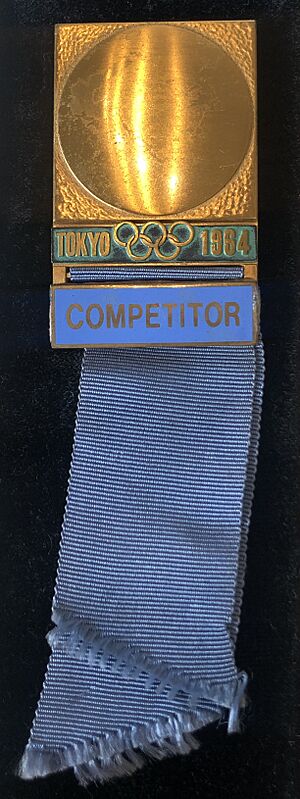
Since the start of the modern Olympics, all athletes, their support teams, event officials, and some volunteers receive special commemorative medals and diplomas. Like the winners' medals, these change for each Olympic Games. Different ones are made for the Summer and Winter Games.
Medal Presentation Ceremonies
The way medals are given out has changed over time. The 1932 Summer Olympics in Los Angeles set the standard for how it's done today. Before 1932, all medals were given at the closing ceremony. Athletes even wore fancy evening clothes for the first few Games.
The victory podium was first used at the 1932 Winter Olympics. The winner stands in the middle on a higher step. The silver medalist stands to their right, and the bronze medalist stands to their left. At the 1960 Summer Olympics, athletes received their medals right after their event for the first time. Later Games have had a podium at each competition venue.
The 1960 Summer Olympics in Rome, Italy, were the first where medals were placed around the athletes' necks. The medals hung from a chain of laurel leaves. Today, they hang from a colored ribbon. When Athens hosted the 2004 Summer Olympics, athletes on the podium also received an olive wreath crown. At the 2016 Summer Olympics in Rio de Janeiro, each medalist received a small wooden statue of the Olympic logo.
For the Winter Olympics, many medals are given out in a separate ceremony in the evening. At the 2002 Winter Olympics in Salt Lake City, a "medals plaza" became popular. This allowed the public to watch the presentations, which often included music performances.
Images for kids
-
Vincent Hancock with his gold medal at the 2012 Summer Olympics, the heaviest Summer Olympics medal prior to the 2016 Rio Olympics
See also
- Lists of Olympic medalists
- Olympic Cup
- Olympic diploma
- Olympic Diploma of Merit
- Olympic Laurel
- Olympic Order
- Summer Olympic coins
- Winter Olympic coins
- James Brendan Connolly, recipient of the first winner's medal
- Pierre de Coubertin Medal, a special medal awarded by the International Olympic Committee for sportsmanship or exceptional service to the Olympic movement


